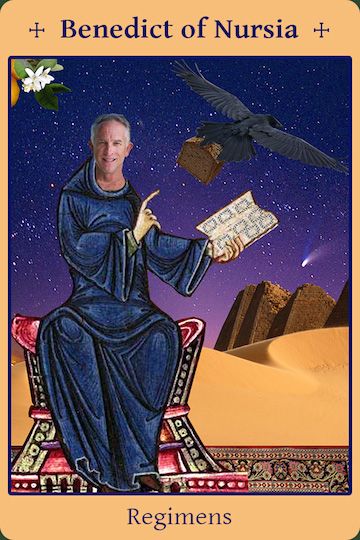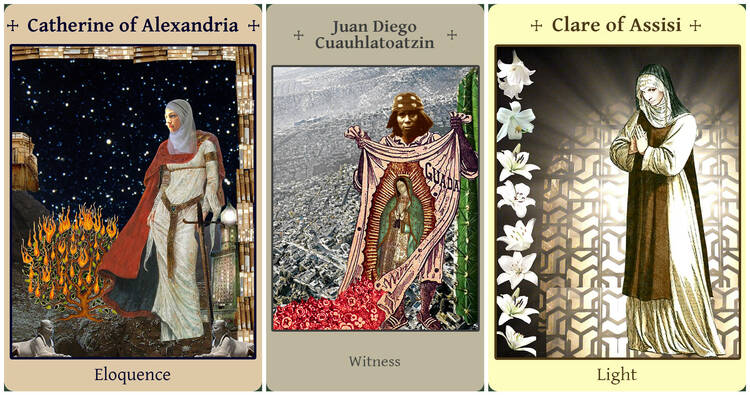During my most recent visit to Silicon Valley, I stayed in the near-ruins of an old NASA facility across some high-voltage lines from the Googleplex, and I got a new set of prayer cards. Perhaps predictably for that region, they were in the form of an app. Less predictable for the region, though, was the raw, teeming faith I found in them and their creator, Elie Calhoun.
I’ve asked Calhoun some questions, and I will let her speak for herself. But allow me to add the news, first, that her apps have just been re-released for both Android and iOS, and you can find links to themon her website.
The first thing that struck me about your cards are the photograph faces—an unusual realism, reminiscent ofJohn Nava’s tapestries in the Cathedral of Our Lady of the Angels in Los Angeles. Who are these people?
When I started the Mary holy cards, which I did first, I was adamant that I wanted to show Our Lady as a real woman, with real women’s facial features and expressions. Most holy cards of her show her as Anglo-Saxon, which we know she wasn’t. I grew up in Kenya and Egypt, seeing statues of Mary that showed her as African or Arab. So I saw the cards as an opportunity to create holy cards of Mary that represent women from all over the world—Native and Latin American, South Asian, East Asian, Arab and African, as well as European. Because she is the mother of the world, I felt these representations were a continuation of the church tradition to make her statues in the image of the people from the local community. The images for the collages I found in the Creative Commons on the internet.
But by the time I got to making the saints cards, I was finding that there weren’t a whole lot of facial images in the Commons that fit the types of expressions and facial angles I was looking for. I was still determined to use photos of real people, though, so I turned to Facebook. I’d pray and meditate about it, and ask the particular saint to help me find the right model, and then I’d comb their Facebook photo feed for the image I needed. I always found it, and then I would do the art and finish the holy card. Only then would I reach out to the friend or family member, and ask permission. It felt really vulnerable, but most times, people said yes. I love that my mother, my sister, my sister-in-law and my friends are the faces of these holy men and women in the cards—real people, just as the saints were.
What kinds of responses have you received? Has this app-making practice connected you with anyone unexpected?

Right now, the holy cards are only available digitally, which I think is confusing for some people, as it’s not really something that’s been done before. I see very orthodox Catholics hesitating to use them because the feature that allows you to either browse the cards or pick a card at random can seem a bit like divination. I try to remind people that we often pick a Bible verse at random or a Psalm at random and that this is a long tradition in our church’s history. I am working on releasing a box set of the Mary and the saints cards, hopefully sometime in late 2017. People seem to really like holding physical things in their hands, although I find that having a digital set of both cards gives me access to prayer at times when I otherwise wouldn’t, like sitting on the train or waiting in line.
You’re re-releasing both sets of cards. Why? What have you changed?
I want the cards to be beacons of love and hope to all who resonate with Mary and the saints, not just to Catholics, so I released them with less dogma and more inclusivity. For example, after speaking to many people, I changed the name of the Mary cards from “Blessed Virgin Mary Holy Cards” to “Mother Mary Holy Cards” because I found that the vast majority of non-Catholics resonate with the Blessed Mother and not necessarily the Blessed Virgin. The cards themselves are non-denominational and can be used by anyone, from any belief system, which is also intentional. After all, the love and healing to be found in prayer and meditation are available to all.
The love and healing to be found in prayer and meditation are available to all.
I appreciate your ecumenism. How would you characterize your own relationship with the Catholic Church?
My Paulist spiritual director calls me the most ecumenical person that he knows, bless him. It comes from my upbringing as the daughter of an aid worker and living in India from ages three to five. I spoke baby Hindi at the time and my ayah, the women who looked after me when my mother was at work for UNICEF, taught me about the gods and goddesses, and how they are all faces of the one God. It made a lot of sense to me at the time. The Vedic stories, with their saints and stories of God-on-Earth, stay close to me, and I often mix my prayers between the Catholic and the Sanskrit, even now.
I grew up with a similar mix, so I know the feeling. Sometimes I find myself practicing ecumenism out of mercy for myself.
I feel the same way about the Catholic Church as I do the U.N. Both represent the grandest, most beautiful dreams of humanity, and both are, like us, deeply flawed. As a feminist and someone growing up during the first crest of the AIDS epidemic in Africa, it was really hard to see men in the church make decisions that went against the very nature of Jesus’ teachings. I love the Gospels, and John especially, and the beatitudes and the Sermon on the Mount remain core teachings that I live by.
I consider myself a prodigal daughter again and again—when I come to the church, and also again when I decide again to leave it.
The reasons I left the contemplative Catholic monastery where I spent my gap year brought a deep schism between me and Rome to this day. That, and reading about the church’s persecution of other Christians (especially Cathars) in the Middle Ages, and the fact that it has not dismantled the arm of the church that was the Inquisition. The church’s insistence I found on obedience to an authority outside of myself, when Jesus clearly says that the kingdom of heaven is within, does not sit well with me. Having grown up under two dictatorships, I already too easily give power away when I shouldn’t and learning to hold my own and speak out without fear around the social justice issues I work on has been a big edge for me.
I would call myself a Christian, but I’m not sure other Christians would agree with me. I don’t think that Jesus is the only path to God, for example; I know too many heart-based Sufis and selfless agnostics to believe that. I also often call myself a Catholic; I definitely act like one. I consider myself a prodigal daughter again and again—when I come to the church, and also again when I decide again to leave it.
So, it’s complicated.
I didn’t know if God would work through mobile phones to send me the right guidance, but God absolutely does.
Yes, for so many of us. So, in the context of a dicey relationship to the institution and tradition, how does the cards’ digital nature change how we might pray with them?
I find that I don’t carry holy cards, or when I do, they get lost and bent in my wallet. The laminated kinds cut my fingers. And although I love them, the facial expressions of the saints and Our Lady just don’t feel real to me; they feel purposely pious and almost expressionless, and that is not how I see those amazing, amazing people who are in a very real way, with us still.
One of my favorite ways to use the cards is the “select a card” feature, where I pick a card at random while holding a prayer intention in my heart. It is absolutely amazing how, just as with picking Bible verses, the right one always comes to me. Despite the cards being randomized, I find that I usually get the same one for similar situations and that usually there is remarkable repetition in the support and guidance through them that I receive. I didn’t know if God would work through mobile phones to send me the right guidance and support (fair question, right?), but God absolutely does. That I find amazing.
I love that anywhere I am—waiting in line, in the car, wherever—I can open the cards and take a moment to connect with a particular saint, or with Our Lady. I use the cards as solace when I am feeling discouraged, as reinforcement when I am making a hard decision, not because I see them as giving me “messages” per se—that is not what they’re for. But in reminding me of the virtues of the saints and of Our Lady, they invite me to bring these qualities into the situation I’m questing about, and that makes all the difference.










